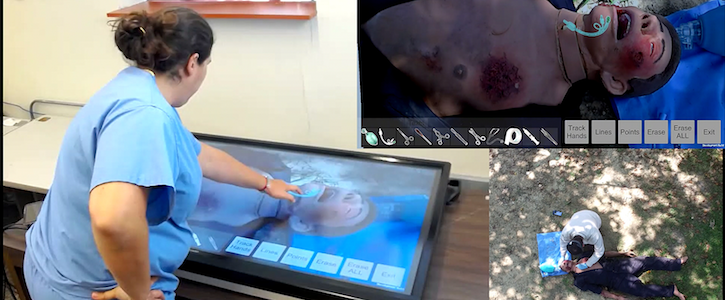Augmented Reality Allows Specialists to Provide Care in Remote Locations
How a new AR system fosters direct care on battlefields and in natural disaster zones and rural areas with the help of on-site medical “mentees.”

Augmented reality could improve medical care in remote locations. Image has been cropped and resized. Courtesy of Purdue University.
Physicians have a new way of providing care to patients in faraway or hard-to-reach places: augmented reality (AR).
Researchers from Purdue University recently unveiled a new AR medicine prototype at the Military Health System Research Symposium. The system could be particularly helpful in places like war zones and natural disaster sites, where clinicians often encounter challenges in trying to reach patients.
>> READ: Telemedical Drones Are Increasing Access to Care in the Face of Natural Disasters
The system facilitates what amounts to an indirect connection between the patient and a physician back at a hospital or base. The creators of the AR describe it as “telementoring,” rather than telemedicine, since the remote mentor physician will be working with and through the help of an on-site mentee. The mentee dons an AR headset, which gives the off-site mentor a first-person view of the patient and of the mentee’s actions. Meanwhile, a drone can be deployed to provide the mentor with a bird’s eye view of the scene.
The headset is transparent — it doesn’t obscure the mentee’s view. However, the mentor physician can draw arrows or surgical instructions over the mentee’s field of vision. The headset also has a stabilizer feature, eliminating video instability caused by rapid movement by the mentee.
“In this sense, people wearing our AR telementoring device would be able to receive extra information as they operate, in addition to maintaining all the visual and motor capabilities they would normally have,” Edward Rojas Muñoz, a doctoral student in industrial engineering at Purdue, told Healthcare Analytics News™.
The system was built to rely on various strengths of internet access, using the WebRTC protocol, which Muñoz said is similar to the framework used by Skype.
“This allows us to have communication of video and audio over the network that handles unstable bandwidth,” he said. “Our communication has proved efficient when communicating over regular Wi-Fi and also over LTE cellular connection.”
In fact, researchers were in the path of the recent storm Hurricane Michael, and they successfully experimented using the AR system over an LTE network as the storm approached.
The research was supported by the U.S. Department of Defense, which sees this type of technology as a means by which to get the expertise of specialists out into the field without having to physically send them there. The AR system is now headed to a Virginia naval base, where over the next few months researchers will test the system in a simulated battlefield setting.
The team at Purdue developed the system along with researchers from the Indiana University School of Medicine and the Eskenazi Health Service, in Indianapolis.
Though AR makes it possible for physicians to treat patients remotely, Muñoz said the technology shouldn’t be seen as taking human care out of the equation. The on-site medical professional, he said, is essential.
“Even though these technologies allow a remote physician to assist during a surgical procedure, the expertise of the local mentee is still required,” he said. “Current artificial intelligence and robotics techniques cannot attempt to remove humans from the loop, especially in scenarios that require critical, real-time assistance (e.g. a battlefield).”
Get the best insights in healthcare analytics directly to your inbox.
Related
The Challenges and Benefits of Implementing Virtual Care
How Telemedicine Helps Victims Heal After Tragedies
Baby Boomers and a Physician Shortage Could Hammer Healthcare. Can Telehealth Help?
Podcast: Match Made in Hospitals — Patient-Matching Technology Can Improve Healthcare
September 21st 2021Clay Ritchey, CEO of Verato, highlights the administrative and financial benefits that patient-matching technology can provide hospitals and health systems, as well as how it can improve the patient experience.
Podcast: Using Digital Solutions to Address Technology Shortfalls with Citius Tech Senior VPs
July 29th 2021In an interview recorded earlier this year, Chief Healthcare Executive Associate Editorial Director Mary Caffrey spoke with 2 leaders of Citius Tech about meeting healthcare challenges with digital solutions.